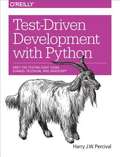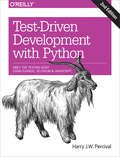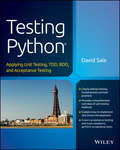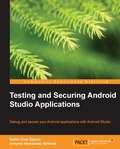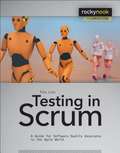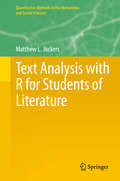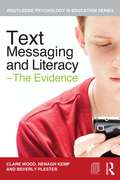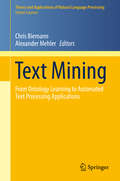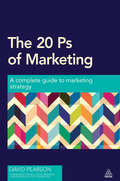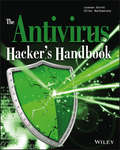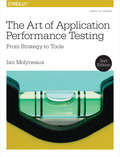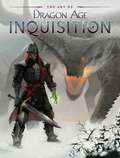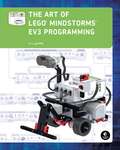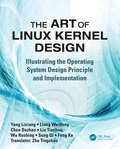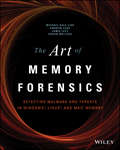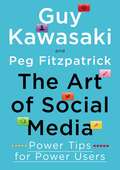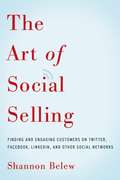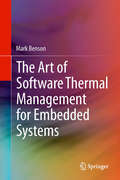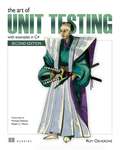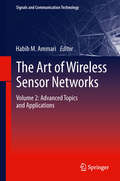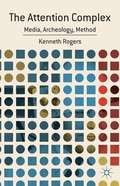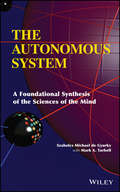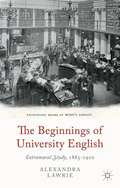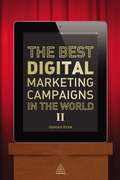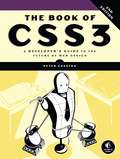- Table View
- List View
Test-Driven Development with Python
by Harry J.W. PercivalBy taking you through the development of a real web application from beginning to end, this hands-on guide demonstrates the practical advantages of test-driven development (TDD) with Python. You'll learn how to write and run tests before building each part of your app, and then develop the minimum amount of code required to pass those tests. The result? Clean code that works.In the process, you'll learn the basics of Django, Selenium, Git, jQuery, and Mock, along with current web development techniques. If you're ready to take your Python skills to the next level, this book clearly demonstrates how TDD encourages simple designs and inspires confidence.Dive into the TDD workflow, including the unit test/code cycle and refactoringUse unit tests for classes and functions, and functional tests for user interactions within the browserLearn when and how to use mock objects, and the pros and cons of isolated vs. integrated testsTest and automate your deployments with a staging serverApply tests to the third-party plugins you integrate into your siteUse a Continuous Integration environment to run your tests automatically
Test-Driven Development with Python: Obey the Testing Goat: Using Django, Selenium, and JavaScript
by Harry PercivalBy taking you through the development of a real web application from beginning to end, the second edition of this hands-on guide demonstrates the practical advantages of test-driven development (TDD) with Python. You’ll learn how to write and run tests before building each part of your app, and then develop the minimum amount of code required to pass those tests. The result? Clean code that works.In the process, you’ll learn the basics of Django, Selenium, Git, jQuery, and Mock, along with current web development techniques. If you’re ready to take your Python skills to the next level, this book—updated for Python 3.6—clearly demonstrates how TDD encourages simple designs and inspires confidence.Dive into the TDD workflow, including the unit test/code cycle and refactoringUse unit tests for classes and functions, and functional tests for user interactions within the browserLearn when and how to use mock objects, and the pros and cons of isolated vs. integrated testsTest and automate your deployments with a staging serverApply tests to the third-party plugins you integrate into your siteRun tests automatically by using a Continuous Integration environmentUse TDD to build a REST API with a front-end Ajax interface
Testing Python
by David SaleFundamental testing methodologies applied to the popular Pythonlanguage Testing Python; Applying Unit Testing, TDD, BDD andAcceptance Testing is the most comprehensive book available ontesting for one of the top software programming languages in theworld. Python is a natural choice for new and experienceddevelopers, and this hands-on resource is a much needed guide toenterprise-level testing development methodologies. The book willshow you why Unit Testing and TDD can lead to cleaner, moreflexible programs.Unit Testing and Test-Driven Development (TDD) are increasinglymust-have skills for software developers, no matter what languagethey work in. In enterprise settings, it's critical for developersto ensure they always have working code, and that's what makestesting methodologies so attractive. This book will teach you themost widely used testing strategies and will introduce to you tostill others, covering performance testing, continuous testing, andmore.Learn Unit Testing and TDD--important developmentmethodologies that lie at the heart of Agile developmentEnhance your ability to work with Python to develop powerful,flexible applications with clean codeDraw on the expertise of author David Sale, a leading UKdeveloper and tech commentatorGet ahead of the crowd by mastering the underappreciated worldof Python testingKnowledge of software testing in Python could set you apart fromPython developers using outmoded methodologies. Python is a naturalfit for TDD and Testing Python is a must-read text foranyone who wants to develop expertise in Python programming.
Testing and Securing Android Studio Applications
by Belen Cruz Zapata Antonio Hernandez NinirolaIf you are a developer with some Android knowledge, but you do not know how to test your applications using Android Studio, this book will guide you. It is recommended that you are familiar with Android Studio IDE.
Testing in Scrum
by Tilo LinzThese days, more and more software development projects are being carried out using agile methods like Scrum. Agile software development promises higher software quality, a shorter time to market, and improved focus on customer needs. However, the transition to working within an agile methodology is not easy. Familiar processes and procedures change drastically. Software testing and software quality assurance have a crucial role in ensuring that a software development team, department, or company successfully implements long-term agile development methods and benefits from this framework. This book discusses agile methodology from the perspective of software testing and software quality assurance management. Software development managers, project managers, and quality assurance managers will obtain tips and tricks on how to organize testing and assure quality so that agile projects maintain their impact. Professional certified testers and software quality assurance experts will learn how to work successfully within agile software teams and how best to integrate their expertise. Topics include:Agile methodology and classic process models How to plan an agile project Unit tests and test first approach Integration testing and continuous integration System testing and test nonstop Quality management and quality assurance Also included are five case studies from the manufacturing, online-trade, and software industry as well as test exercises for self-assessment. This book covers the new ISTQB Syllabus for Agile Software Testing and is a relevant resource for all students and trainees worldwide who plan to undertake this ISTQB certification.
Text Analysis with R for Students of Literature
by Matthew L. JockersText Analysis with R for Students of Literature is written with students and scholars of literature in mind but will be applicable to other humanists and social scientists wishing to extend their methodological tool kit to include quantitative and computational approaches to the study of text. Computation provides access to information in text that we simply cannot gather using traditional qualitative methods of close reading and human synthesis. Text Analysis with R for Students of Literature provides a practical introduction to computational text analysis using the open source programming language R. R is extremely popular throughout the sciences and because of its accessibility, R is now used increasingly in other research areas. Readers begin working with text right away and each chapter works through a new technique or process such that readers gain a broad exposure to core R procedures and a basic understanding of the possibilities of computational text analysis at both the micro and macro scale. Each chapter builds on the previous as readers move from small scale "microanalysis" of single texts to large scale "macroanalysis" of text corpora, and each chapter concludes with a set of practice exercises that reinforce and expand upon the chapter lessons. The book's focus is on making the technical palatable and making the technical useful and immediately gratifying.
Text Messaging and Literacy – The Evidence
by Clare Wood Nenagh Kemp Beverly Plester"Well thought out and timely. This is the leading group in the world working on texting and literacy, and they have a strong track record of publications. It would also be the first book, as they say, to deal with the subject at an academic level. The focus on education is important, as this is where most of the anxieties lie. It will be a major step forward in creating a new climate." Professor David Crystal, author of The Cambridge Encyclopaedia of Language and The Cambridge Encyclopaedia of the English Language, Television consultant and presenter As children are given mobile phones at increasingly younger ages, there is considerable media coverage of claims that mobile phones, and text messaging in particular, are responsible for declining levels of literacy in children and young people. Such claims are often adopted wholesale by teachers and parents, despite the fact that there is an empirical literature which has failed to find a basis to these claims, and to the contrary has found that text messaging is supporting children’s literacy skills. Written by leading international researchers Text Messaging and Literacy presents an overview and discussion of the academic evidence for and against use of text messaging and mobile phones in supporting literate activity and discusses what conclusions we can and should draw about the impact of mobile phones, and their potential role in education. Areas covered include: the rise of texting and media reactions; children’s reading, spelling and texting; text messaging of children with language difficulties; using mobile phones for literacy development; texting and literacy skills in adolescents and adults; spelling and grammar in texting and beyond; the future of texting. In challenging existing assumptions the authors present the cutting edge of international research, highlighting their own studies involving children of all ages, adolescents and adults. This ground breaking book is essential reading for both researchers and students in education, educational psychology, literacy and new media and it’s impact on learning.
Text Mining
by Alexander Mehler Chris BiemannThis book comprises a set of articles that specify the methodology of text mining, describe the creation of lexical resources in the framework of text mining and use text mining for various tasks in natural language processing (NLP). The analysis of large amounts of textual data is a prerequisite to build lexical resources such as dictionaries and ontologies and also has direct applications in automated text processing in fields such as history, healthcare and mobile applications, just to name a few. This volume gives an update in terms of the recent gains in text mining methods and reflects the most recent achievements with respect to the automatic build-up of large lexical resources. It addresses researchers that already perform text mining, and those who want to enrich their battery of methods. Selected articles can be used to support graduate-level teaching. The book is suitable for all readers that completed undergraduate studies of computational linguistics, quantitative linguistics, computer science and computational humanities. It assumes basic knowledge of computer science and corpus processing as well as of statistics.
The 20 Ps of Marketing
by David PearsonMarketing has changed dramatically since the four classic Ps of the marketing mix (price, product, promotion and place) were proposed. The new marketing landscape is characterised by the demand for constant innovation, rising pressure on budgets, the growth of social media and the impact of issues of sustainability and ethical issues. As the business landscape has transformed so have the fundamental areas marketers need to master to succeed.The 20 Ps of Marketing provides a thorough guide to marketers at all levels of the new elements of the marketing mix they need to contend with for business success including: planning; persuasion; publicity; positioning; productivity; partnerships; passion and more. Combining practical advice with case studies it covers brands that have changed the game through mastery of the 20 Ps such as H agen Daz and Sony, and others, such as Kodak, who got left behind.This essential guide to the current face of marketing strategy provides marketers with a thorough and valuable grounding to the new fundamentals of marketing.
The Antivirus Hacker's Handbook
by Elias Bachaalany Joxean KoretThe book focusses on how to reverse engineer antivirus software, detect vulnerabilities and exploit them. This knowledge can benefit both an attacker (legal or otherwise, as happens with any kind of knowledge) as well as antivirus software vendors. It's composed of the following sections: Reverse engineering antivirus software Antivirus software evasion Attacking antivirus software Exploiting antivirus software Conclusions about current state-of-the-art of antivirus software Recommendations to both users and vendors
The Art of Application Performance Testing: From Strategy to Tools
by Ian MolyneauxBecause performance is paramount today, this thoroughly updated guide shows you how to test mission-critical applications for scalability and performance before you deploy them—whether it’s to the cloud or a mobile device. You’ll learn the complete testing process lifecycle step-by-step, along with best practices to plan, coordinate, and conduct performance tests on your applications.Set realistic performance testing goalsImplement an effective application performance testing strategyInterpret performance test resultsCope with different application technologies and architecturesUnderstand the importance of End User Monitoring (EUM)Use automated performance testing toolsTest traditional local applications, web applications, and web servicesRecognize and resolves issues often overlooked in performance testsWritten by a consultant with over 15 years’ experience with performance testing, The Art of Application Performance Testing thoroughly explains the pitfalls of an inadequate testing strategy and offers a robust, structured approach for ensuring that your applications perform well and scale effectively when the need arises.
The Art of Dragon Age: Inquisition (Dragon Age)
by BiowareThe next generation of fantasy is here! Go behind the scenes of Dragon Age: Inquisition, the most ambitious game ever created by legendary developer BioWare!Featuring hundreds of never-before-seen artworks and captions from the developers themselves, this volume offers revealing insight into the inspiration and creation of every facet of Dragon Age: Inquisition, from the heroes, to the wondrous weapons they wield, the powerful beasts that they battle, and the extraordinary world that they inhabit.
The Art of LEGO MINDSTORMS EV3 Programming
by Terry GriffinWith its colorful, block-based interface, The LEGO® MINDSTORMS® EV3 programming language is designed to allow anyone to program intelligent robots, but its powerful features can be intimidating at first. The Art of LEGO MINDSTORMS EV3 Programming is a full-color, beginner-friendly guide designed to bridge that gap.Inside, you’ll discover how to combine core EV3 elements like blocks, data wires, files, and variables to create sophisticated programs. You’ll also learn good programming practices, memory management, and helpful debugging strategies—general skills that will be relevant to programming in any language.All of the book’s programs work with one general-purpose test robot that you’ll build early on. As you follow along, you’ll program your robot to:–React to different environments and respond to commands–Follow a wall to navigate a maze–Display drawings that you input with dials, sensors, and data wires on the EV3 screen–Play a Simon Says–style game that uses arrays to save your high score–Follow a line using a PID-type controller like the ones in real industrial systemsThe Art of LEGO MINDSTORMS EV3 Programming covers both the Home and Education Editions of the EV3 set, making it perfect for kids, parents, and teachers alike. Whether your robotics lab is the living room or the classroom, this is the complete guide to EV3 programming that you’ve been waiting for.Requirements: One LEGO MINDSTORMS EV3 Home OR Education set (#31313 OR #45544).
The Art of Linux Kernel Design: Illustrating the Operating System Design Principle and Implementation
by Lixiang YangUses the Running Operation as the Main Thread Difficulty in understanding an operating system (OS) lies not in the technical aspects, but in the complex relationships inside the operating systems. The Art of Linux Kernel Design: Illustrating the Operating System Design Principle and Implementation addresses this complexity. Written from the perspective of the designer of an operating system, this book tackles important issues and practical problems on how to understand an operating system completely and systematically. It removes the mystery, revealing operating system design guidelines, explaining the BIOS code directly related to the operating system, and simplifying the relationships and guiding ideology behind it all. Based on the Source Code of a Real Multi-Process Operating System Using the 0.11 edition source code as a representation of the Linux basic design, the book illustrates the real states of an operating system in actual operations. It provides a complete, systematic analysis of the operating system source code, as well as a direct and complete understanding of the real operating system run-time structure. The author includes run-time memory structure diagrams, and an accompanying essay to help readers grasp the dynamics behind Linux and similar software systems. Identifies through diagrams the location of the key operating system data structures that lie in the memory Indicates through diagrams the current operating status information which helps users understand the interrupt state, and left time slice of processes Examines the relationship between process and memory, memory and file, file and process, and the kernel Explores the essential association, preparation, and transition, which is the vital part of operating system Develop a System of Your Own This text offers an in-depth study on mastering the operating system, and provides an important prerequisite for designing a whole new operating system.
The Art of Memory Forensics
by Andrew Case Michael Hale Ligh Jamie Levy Aaron WaltersMemory forensics provides cutting edge technology to help investigate digital attacksMemory forensics is the art of analyzing computer memory (RAM) to solve digital crimes. As a follow-up to the best seller Malware Analyst's Cookbook, experts in the fields of malware, security, and digital forensics bring you a step-by-step guide to memory forensics--now the most sought after skill in the digital forensics and incident response fields.Beginning with introductory concepts and moving toward the advanced, The Art of Memory Forensics: Detecting Malware and Threats in Windows, Linux, and Mac Memory is based on a five day training course that the authors have presented to hundreds of students. It is the only book on the market that focuses exclusively on memory forensics and how to deploy such techniques properly. Discover memory forensics techniques:How volatile memory analysis improves digital investigationsProper investigative steps for detecting stealth malware and advanced threatsHow to use free, open source tools for conducting thorough memory forensicsWays to acquire memory from suspect systems in a forensically sound mannerThe next era of malware and security breaches are more sophisticated and targeted, and the volatile memory of a computer is often overlooked or destroyed as part of the incident response process. The Art of Memory Forensics explains the latest technological innovations in digital forensics to help bridge this gap. It covers the most popular and recently released versions of Windows, Linux, and Mac, including both the 32 and 64-bit editions.
The Art of Social Media: Power Tips For Power Users
by Guy Kawasaki Peg FitzpatrickBy now it's clear that whether you're promoting a business, a product, or yourself, social media is near the top of what determines your success or failure. And there are countless pundits, authors, and consultants eager to advise you. But there's no one quite like Guy Kawasaki, the legendary former chief evangelist for Apple and one of the pioneers of business blogging, tweeting, Facebooking, Tumbling, and much, much more. Now Guy has teamed up with Peg Fitzpatrick, who he says is the best social-media person he's ever met, to offer The Art of Social Media--the one essential guide you need to get the most bang for your time, effort, and money. With over one hundred practical tips, tricks, and insights, Guy and Peg present a bottom-up strategy to produce a focused, thorough, and compelling presence on the most popular social-media platforms. They guide you through steps to build your foundation, amass your digital assets, optimize your profile, attract more followers, and effectively integrate social media and blogging. For beginners overwhelmed by too many choices as well as seasoned professionals eager to improve their game, The Art of Social Media is full of tactics that have been proven to work in the real world. Or as Guy puts it, "great stuff, no fluff."
The Art of Social Selling: Finding And Engaging Customers On Twitter, Facebook, Linkedin, And Other Social Networks
by Shannon BelewSocial media platforms such as Facebook, Twitter, LinkedIn, and Pinterest are changing the way consumers make purchasing decisions . . . and tapping into these online communities has become a necessary part of any integrated sales strategy. Citing enlightening research and real-world examples, this smart, practical guide presents readers with a detailed methodology for growing sales and expanding their customer base using social media. Readers will learn how to: * Use content and conversations to build online relationships that transition to sales * Execute realistic sales strategies for each of the major social media platforms * Spot social media trends that may influence future buying behaviors * Sell online in B2B and B2C environments * Turn social shares (likes, favorites, +1s) into social sales * Set tangible goals * Use online tools and analytics to track social influencers and identify relevant conversations as they are happening Complete with a chapter dedicated to capturing mobile sales--a segment poised to explode as the adoption of smartphones and tablets grows--The Art of Social Selling is essential reading for every sales professional.
The Art of Software Thermal Management for Embedded Systems
by Mark BensonThis book introduces Software Thermal Management (STM) as a means of reducing power consumption in a computing system in order to manage heat, improve component reliability and increase system safety. Readers will benefit from this pragmatic guide to the field of STM for embedded systems and its catalog of software power management techniques. Since thermal management is a key bottleneck in embedded systems design, this book focuses on root cause of heat in embedded systems: power. Since software has an enormous impact on power consumption in an embedded system, this book urges software engineers to manage heat effectively by understanding, categorizing and developing new ways to reduce static and dynamic power consumption. Whereas most books on thermal management describe mechanisms to remove heat, this book focuses on ways for software engineers to avoid generating heat in the first place.
The Art of Unit Testing: with examples in C#
by Roy OsheroveSummaryThe Art of Unit Testing, Second Edition guides you step by step from writing your first simple tests to developing robust test sets that are maintainable, readable, and trustworthy. You'll master the foundational ideas and quickly move to high-value subjects like mocks, stubs, and isolation, including frameworks such as Moq, FakeItEasy, and Typemock Isolator. You'll explore test patterns and organization, working with legacy code, and even "untestable" code. Along the way, you'll learn about integration testing and techniques and tools for testing databases and other technologies.About this BookYou know you should be unit testing, so why aren't you doing it? If you're new to unit testing, if you find unit testing tedious, or if you're just not getting enough payoff for the effort you put into it, keep reading.The Art of Unit Testing, Second Edition guides you step by step from writing your first simple unit tests to building complete test sets that are maintainable, readable, and trustworthy. You'll move quickly to more complicated subjects like mocks and stubs, while learning to use isolation (mocking) frameworks like Moq, FakeItEasy, and Typemock Isolator. You'll explore test patterns and organization, refactor code applications, and learn how to test "untestable" code. Along the way, you'll learn about integration testing and techniques for testing with databases.The examples in the book use C#, but will benefit anyone using a statically typed language such as Java or C++.Purchase of the print book includes a free eBook in PDF, Kindle, and ePub formats from Manning Publications.What's InsideCreate readable, maintainable, trustworthy testsFakes, stubs, mock objects, and isolation (mocking) frameworksSimple dependency injection techniquesRefactoring legacy codeAbout the AuthorRoy Osherove has been coding for over 15 years, and he consults and trains teams worldwide on the gentle art of unit testing and test-driven development. His blog is at ArtOfUnitTesting.com.Table of ContentsPART 1 GETTING STARTEDThe basics of unit testingA first unit testPART 2 CORE TECHNIQUESUsing stubs to break dependenciesInteraction testing using mock objectsIsolation (mocking) frameworksDigging deeper into isolation frameworksPART 3 THE TEST CODETest hierarchies and organizationThe pillars of good unit testsPART 4 DESIGN AND PROCESSIntegrating unit testing into the organizationWorking with legacy code Design and testability
The Art of Wireless Sensor Networks
by Habib M. AmmariDuring the last one and a half decades, wireless sensor networks have witnessed significant growth and tremendous development in both academia and industry. "The Art of Wireless Sensor Networks: Volume 1: Fundamentals" focuses on the fundamentals concepts in the design, analysis, and implementation of wireless sensor networks. It covers the various layers of the lifecycle of this type of network from the physical layer up to the application layer. Its rationale is that the first volume covers contemporary design issues, tools, and protocols for radio-based two-dimensional terrestrial sensor networks. All the book chapters in this volume include up-to-date research work spanning various classic facets of the physical properties and functional behavior of wireless sensor networks, including physical layer, medium access control, data routing, topology management, mobility management, localization, task management, data management, data gathering, security, middleware, sensor technology, standards, and operating systems. This book will be an excellent source of information for both senior undergraduate and graduate students majoring in computer science, computer engineering, electrical engineering, or any related discipline. In addition, computer scientists, researchers, and practitioners in both academia and industry will find this book useful and interesting.
The Attention Complex
by Kenneth RogersOver the past two decades in the United States, a profound reorientation of human attention has taken shape. This book addresses the recent cultural anxiety about attention as a way of negotiating a crisis of the self that is increasingly managed, mediated, and controlled by technologies.
The Autonomous System
by Szabolcs Michael de Gyurky Mark A. TarbellThe Fundamental Science in "Computer Science" Is the Science of ThoughtFor the first time, the collective genius of the great 18th-century German cognitive philosopher-scientists Immanuel Kant, Georg Wilhelm Friedrich Hegel, and Arthur Schopenhauer have been integrated into modern 21st-century computer science.In contrast to the languishing mainstream of Artificial Intelligence, this book takes the human thought system as its model, resulting in an entirely different approach. This book presents the architecture of a thoroughly and broadly educated human mind as translated into modern software engineering design terms.The result is The Autonomous System, based on dynamic logic and the architecture of the human mind. With its human-like intelligence, it is capable of rational thought, reasoning, and an understanding of itself and its tasks."A system of thoughts must always have an architectural structure."--Arthur Schopenhauer, The World as Will and Presentation
The Beginnings of University English
by Alexandra LawrieDrawing on previously unseen archival material, The Beginnings of University English explores the innovative and scholarly ways in which English literature was taught to extramural students in England during the fin de si#65533;cle, and sheds new light on the modern roots of tertiary-level English teaching.
The Best Digital Marketing Campaigns in the World II
by Damian RyanIn the second collection of The Best Digital Marketing Campaigns in the World, bestselling author Damian Ryan presents an international showcase of the most successful digital marketing campaigns in recent history.Full of behind-the-scenes insights into campaign strategy, implementation and results, it explores how businesses and agencies large and small have harnessed social media, blogs, video, email, mobile and search to boost their brand and attract customers. Covering a wide range of world-class, award-winning campaigns including Redbull and Stratos, Evian's 31 ways to live young, and Students Beans' Freshers' Field, The Best Digital Marketing Campaigns in the World is an inspirational showcase of digital creativity and a must-read for everyone working in marketing and advertising.
The Book of CSS3, 2nd Edition: A Developer's Guide to the Future of Web Design
by Peter GasstonCSS3 is the technology behind most of the eye-catching visuals on the Web. But the docs can be dry, murky, and full of dastardly caveats for inconsistent browser implementations.This completely updated second edition of the best-selling Book of CSS3 distills the dense technical language of the CSS3 specification into plain English and shows you what CSS3 can do now, in all major browsers. You’ll find fully revised coverage of the updated syntax of gradients, grids, and flexible box layout, as well as all-new chapters on values and sizing, and graphical effects like filter effects and blend modes.With an abundance of real-world examples and a focus on the principles of good design, The Book of CSS3 will help you expand your CSS skills, as you learn how to:–Style text with custom font choices, drop shadows, and other effects–Create, position, and resize background images on the fly–Spice up static web pages with event-driven transitions and animations–Apply 2D and 3D transformations to text and images–Use linear and radial gradients to create smooth color transitions–Take control of layout with grids, columns, and flexible alignment–Tailor a website’s appearance to every type of web-capable deviceThe companion website includes up-to-date browser compatibility charts, links to tutorials and resources, and live CSS3 examples.The Web can be an ugly place. Make it pretty with The Book of CSS3.
